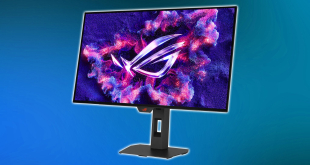Over two years on since the launch of the Ampere architecture and the RTX 30-series, Nvidia is back with a bang, launching the company's latest flagship – the RTX 4090. Heralded as the ‘ultimate GeForce GPU', RTX 4090 is built on the new Ada Lovelace architecture, offering a number of technological improvements over its predecessors.
There's no other place to start this conclusion than with the sheer generational uplift that is offered by the RTX 4090. For 4K gaming, it is 60% faster on average than the RTX 3090 Ti, and 80% faster on average when compared to the RTX 3090. Up against AMD's current flagship, the RX 6950 XT, it offers 75% better performance.
It may take a while for those numbers to sink in, but to give it some context, the data from my day one RTX 3090 review saw that GPU offer 48% better performance than the previous flagship, the RTX 2080 Ti. Fast forward two years and the RTX 4090 has smashed both the 3090 and 3090 Ti out of the water by an even greater margin.
That level of performance means we were able to drive every single game we tested at 4K60 with ease. In fact, over the 12 games tested, the RTX 4090 produced an average frame rate of 135 FPS at 4K, the worst result being 74 FPS in Cyberpunk 2077.
Speaking of resolutions, there's no doubt in my mind that the RTX 4090 was designed for 4K and above. It is still significantly faster than the RTX 3090 Ti at 1440p, but it doesn't scale as well at the lower resolutions – it's 48% faster on average at 1440p, and just 31% faster on average at 1080p. The reason for this appears to be a combination of both CPU limitations and also the FP32-heavy architecture, something we observed with Ampere but is now exacerbated by Ada, particularly with the RTX 4090 offering 16384 cores.
The move to Ada and the 3rd Generation RT Core design has also seen ray tracing performance come on significantly. Here the RTX 4090 scales even better against the RTX 3090 Ti, offering an 82% uplift in Cyberpunk 2077 using the Ray Tracing Ultra preset, while it's also over twice as fast as the RTX 3090 in Marvel's Spider-Man Remastered when testing at 4K.
While trying to avoid any unnecessary hyperbole, I do think this could be a watershed moment for ray tracing in games, with the performance on offer from the RTX 4090 making ray tracing feel like much less of a compromise between fidelity and frame rates. Even with the RTX 3090 Ti, enabling every single ray-traced effect in certain games could result in an unplayable experience, and while we do need to test a larger quantity of ray-traced games, that looks like much less of a problem for the RTX 4090.
Of course, DLSS 3 aims to make that compromise a thing of the past, but we aren't quite ready yet to pass judgement on the technology just yet, simply due to the time spent on this review alone. Our video review includes a brief comparison with DLSS 3 in Cyberpunk 2077 and it certainly looks very promising based on my early impressions, but a full analysis will have to wait for the near future.
Switching back to the RTX 4090 Founders Edition, the fundamental design hasn't changed since the 30-series, but Nvidia has made a few tweaks to improve overall cooling performance. These include the switch to larger, 120mm fans, fluid dynamic bearings and also the fact that each fan now spins in an opposite direction to the other.
In practice, the card performed very well, hitting a peak temperature of 70C after an extended stress test in Metro Exodus Enhanced Edition – a game where we measured 461W of power draw, so this is about as tough as it gets for GPU load right now. Noise levels are perhaps a touch louder than we might have expected given the very quiet fan profile on the 30-series, but again, this is a 450W GPU so our expectations may need to shift slightly – and it was still far from loud.
Speaking of power draw, this review has utilised our in-depth GPU power testing methodology, so if you want to see power draw figures on a per-game and per-resolution basis, you can find that starting on page 28 of this review. We found that the RTX 4090 consistently operated below its 450W TGP rating, with average power draw hitting 389W at 4K. Certain loads – including Metro Exodus Enhanced Edition and Cyberpunk 2077 with the Ray Tracing Ultra preset – would get us up to 450W of juice, but many titles saw significantly lower power draw.
That's certainly a good thing though and coupled with the sheer horsepower of the AD102 GPU, the RTX 4090 is a new performance per Watt champion, offering overall efficiency that is head and shoulders above the competition. At 4K, the next most efficient GPU we tested is the RTX 3070, and the 4090 offers 50% better performance per Watt than that. Compared to the RTX 3090 Ti and we're talking efficiency gains of 80+% which is quite staggering. That bodes well for the rest of the 40-series line up too, with the lower-power SKUs typically offering even greater efficiency.
On that note, however, if I may add a word of caution – it would be easy to look at the performance numbers in this review and get carried away, but I do want to stress that this article is an RTX 4090 review. In other words, what we say here doesn't necessarily apply to the two RTX 4080 SKUs, or the rest of the currently unrevealed 40-series family.
That's particularly important considering the pricing, as with the RTX 4090 hitting the market at £1699, it is only going to be a viable option for a niche customer – the kind of person who wants the best of the best and doesn't care what it will cost. For the customer who does care about cost per frame and overall value… well, the RTX 4090 certainly isn't for you. Instead, we will have to wait and see what is forthcoming from the rest of the 40-series product line – and let's not forget RDNA 3 which is launching next month.
For now, there's no two ways about it – the Nvidia RTX 4090 is a mightily impressive graphics card, offering a stunning generational uplift over the RTX 3090 and RTX 3090 Ti. If you can afford one, you are in for a real treat – but I'm eager to see what comes next from Nvidia for those who can't justify spending £1699 on a graphics card…
Discuss on our Facebook page HERE.
Pros
- Huge performance uplift versus RTX 3090 Ti and RTX 3090.
- Ray tracing is significantly more viable than with Ampere.
- New performance per Watt champion.
- Power draw is actually lower than the 3090 Ti.
- Founders Edition runs cool and isn’t loud.
- We hit 3GHz once overclocked.
Cons
- Very expensive at £1699.
- Founders Edition is monstrously large.
KitGuru says: We could run out of superlatives to describe the RTX 4090, but we'll keep it short: it's hella fast, and hella expensive.
 KitGuru KitGuru.net – Tech News | Hardware News | Hardware Reviews | IOS | Mobile | Gaming | Graphics Cards
KitGuru KitGuru.net – Tech News | Hardware News | Hardware Reviews | IOS | Mobile | Gaming | Graphics Cards




